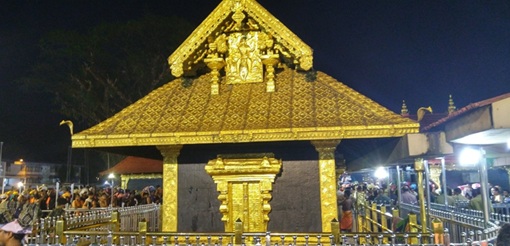| (Prelims: Arts and Culture) |
Why in the News
On October 22, 2025, President Draupadi Murmu visited the Sabarimala Ayyappa Temple, becoming the first woman President of the country to worship at this famous temple. Also, a Special Investigation Team (SIT) investigation is underway into the theft of gold from the temple.

About the Sabarimala Temple
- The Sabarimala Sri Ayyappa Swami Temple is a major pilgrimage site in Kerala, dedicated to Lord Ayyappa.
- The temple opens only at certain times of the year, such as during the Mandalam-Makaravilakku season (November to January), and millions of devotees visit the temple, observing a 41-day fast.
- Pilgrims wear black robes, carry Irumudi (two bags), and chant "Swami Sharanam Ayyappa."
- The temple also houses shrines to Vavar Swami (a Muslim saint) and Malikappuram Devi, symbolizing religious harmony.
Historical Facts
- The temple is believed to have been founded around 800 years ago, although it is mentioned in ancient texts.
- According to legend, Ayyappa is the son of Shiva and Mohini (a female form of Vishnu), who slew the demoness Mahishi.
- The temple was built by King Rajasekhara.
- King Rajasekhara was a renowned Sanskrit poet, playwright, and critic who worked in the court of the Gurjara Pratihara king Mahendrapala I and his son Mahipala in the 10th century. He is best known for his two important works, Kavyamimamsa and Karpuramanjari.
- Vavar Swami (a Muslim warrior) is considered a friend of Ayyappa, symbolizing Hindu-Muslim harmony.
- The Jyoti Darshan (lighting ceremony) during the Makaravilakku festival holds historical significance.
Location
- The Sabarimala Temple is located in the Perinad village of Pathanamthitta district in Kerala, on the Sabari Hills in the Western Ghats.
- It is surrounded by 18 hills of the Periyar Tiger Reserve, and is at an altitude of approximately 914 meters above sea level.
Architecture
- The Sabarimala Temple follows the traditional Kerala style of architecture, which is simple and spiritual.
- The main structure has a golden roof (copper plated), and the idol of Ayyappa is installed in the sanctum sanctorum in a yoga posture.
- The entrance to the temple has 18 sacred steps (Pathinettam Padi), symbolizing the 18 hills or 18 virtues, and is covered with a gold plating.
- There is a lamp post and other smaller shrines in front of the idol of the Lord.
- The temple was rebuilt after a fire in 1950.
Controversy surrounding women's entry
- There has been a long-standing controversy over the entry of women (10-50 years old) into the Sabarimala temple, which was prohibited according to temple tradition.
- Lord Ayyappa, the deity of the Sabarimala temple, is considered a 'perpetual celibate,' so women of reproductive age were traditionally not allowed entry.
- In 1991, the Kerala High Court upheld this practice.
- In 2006, the Indian Young Lawyers Association petitioned the Supreme Court to allow women aged 10 to 50 to enter the temple.
- Following a Supreme Court ruling in 2018, women were allowed entry, but this led to widespread protests.
Supreme Court Decision
- On September 28, 2018, the Supreme Court ruled by a 4:1 majority that the ban on temple entry for women aged 10 to 50 years was unconstitutional, as it violated women's right to equality (Articles 14, 15, and 25).
- Chief Justice Deepak Mishra, Justices RF Nariman, AM Khanwilkar, and DY Chandrachud delivered the majority verdict, while Justice Indu Malhotra, the only woman on the bench, dissented.
- The Court held that the practice is not an essential religious practice, and that women have the right to worship.
- In 2019, the Court heard review petitions, but the original verdict remained intact.
Significance of the Temple
- The Sabarimala Temple holds spiritual, cultural, and social significance.
- It is a symbol of equality, love, and devotion, where people of all castes and religions observe the same fast.
- The temple is dedicated to Ayyappa, the savior of Kaliyuga, and the pilgrimage teaches discipline, renunciation, and unity.
- It boosts Kerala's economy and is an example of religious harmony (Hindu-Muslim).
- The Supreme Court's decision strengthened gender equality, although controversy continues. Globally, it reflects the diversity of Hinduism.



